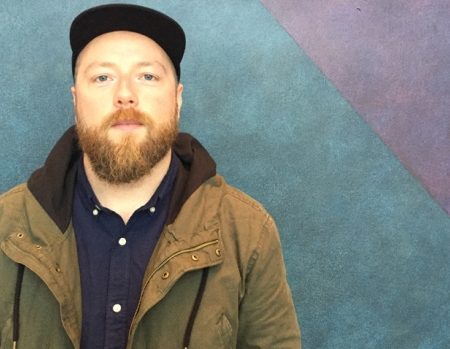Your body of work relates music to its recipient. In some cases, music is manifested in objects such as in Sun Ship Machine Gun – Metallurgy I, where you follow the trajectory of metals sourced from WWII discarded artillery in the making of saxophones and church bells. Like in many of your works, you compose a performance using video, a live saxophonist, and have carefully chosen the site of a church in which to present the piece. You’ve described this as exploring a “sonic evolution”. Can you explain how a sonic evolution can happen alongside the evolution of materials?
The principle component of Sun Ship Machine Gun – Metallurgy I is the audio soundtrack I composed with Joel Waddell that sonically imagines the narrative of non-ferrous metal shape-shifting through various states of flux and solidification. The other components (video, sculpture, poetry, musical performance) comprising the installation emerged in response to the soundtrack.
Sun Ship Machine Gun – Metallurgy I strives to sublimate this purported narrative of metallurgical transmutation into sound. The artwork’s system of belief regards sound/music as a kind of perceptual and ethereal by-product innate to the metal’s imagined industrial processing and evolution. For this artwork sound/music are held to the task of extricating certain social and historical narratives resting dormant in the metal objects under investigation.
How does your artwork manifest outside of performance?
My work manifests in many ways. I create installations that combine a variety of media such as sculpture, sound, video, musical composition, printed matter, and more. Live and/or documented musical performance has been incorporated in several of my most recent artworks. Musical performance is most often used to bring an artwork’s musical composition to life as well as transmit it sonically back into its site of influence/origin.
An artwork usually begins with a diagrammatic or compositional drawing that serves as a springboard and guiding map for the work’s development and accompanying musical score. During the creation of the artwork chance and inspired deviations from this map are embraced.
Your artworks can be described as projects since they involve an invested research of architectural diagrams, original music composition, rehearsals, casting and working in collaboration. This is a process that should take a year or more to produce but is often forced into shorter time frames. What does productivity mean to you as an artist and do you find it difficult to resolve producing works of art that relate more to the process of theatre production and performance with the demands of contemporary visual art presentation?
My projects are most often collaborative so it usually takes much more time than anticipated to produce an artwork for exhibition. When creating artworks intended for public spaces –that are of a more performative and/or theatrical nature– the time for production, planning and rehearsals diminishes quickly. Regardless working in this manner is never dull and always inspiring and educational. Time is the most precious commodity.
In the performance and installation Parchetypes, you created two mythical characters: the Anonymous Bagpiper and the Gatekeeper, forming an unlikely pairing of figures made into collaborating archetypes. How important is it to you that your audience understand the histories from which you draw and do you purposely remix the story of objects and historical protagonists?
I am intrigued by narratives that blur the lines between fact and fiction. Certain stories and protagonists I have used in the past, especially of a certain degree of historical murkiness, are intentionally integrated into the conceptual framework of a project. Yet it is always my hope the audience can glean their own understanding of the work exempt of its conceptual backstory.
You are interested in the sound of architecture and mentioned the well known quote by Baroque architect Johann Wolfgang von Goethe: “Architecture is frozen music…” based on the concept that music is formed by the space it inhabits. Can you let us in on how this meditation enters your art making, in particular for your Brutalist Song series?
Goethe’s quote still serves as inspiration and affirmation for my ongoing Brutalist Song series, which translates Brutalist buildings into music and related art objects. For me, Goethe’s quote poetically summarizes the idea that physical and representational parameters of a building mold can dictate the sonic activity, culture and output being formed within it. The various defining characteristics of a specific kind of music are dictated by the architectural space this music is bouncing around and interacting with during its time of creation. Considering music as a mode that effectively transmits ideas without language, I believe music/sound has the ability to formulate and release the tangible/intangible attributes of a building, and visa versa.
What’s next?
I will exhibiting Pickark Quarry Transpose at Artspace in Peterborough ON from Jul 28 – Sep 9, 2017. I will exhibition a new body of work at TRUCK in Calgary AB this January, 2018.
